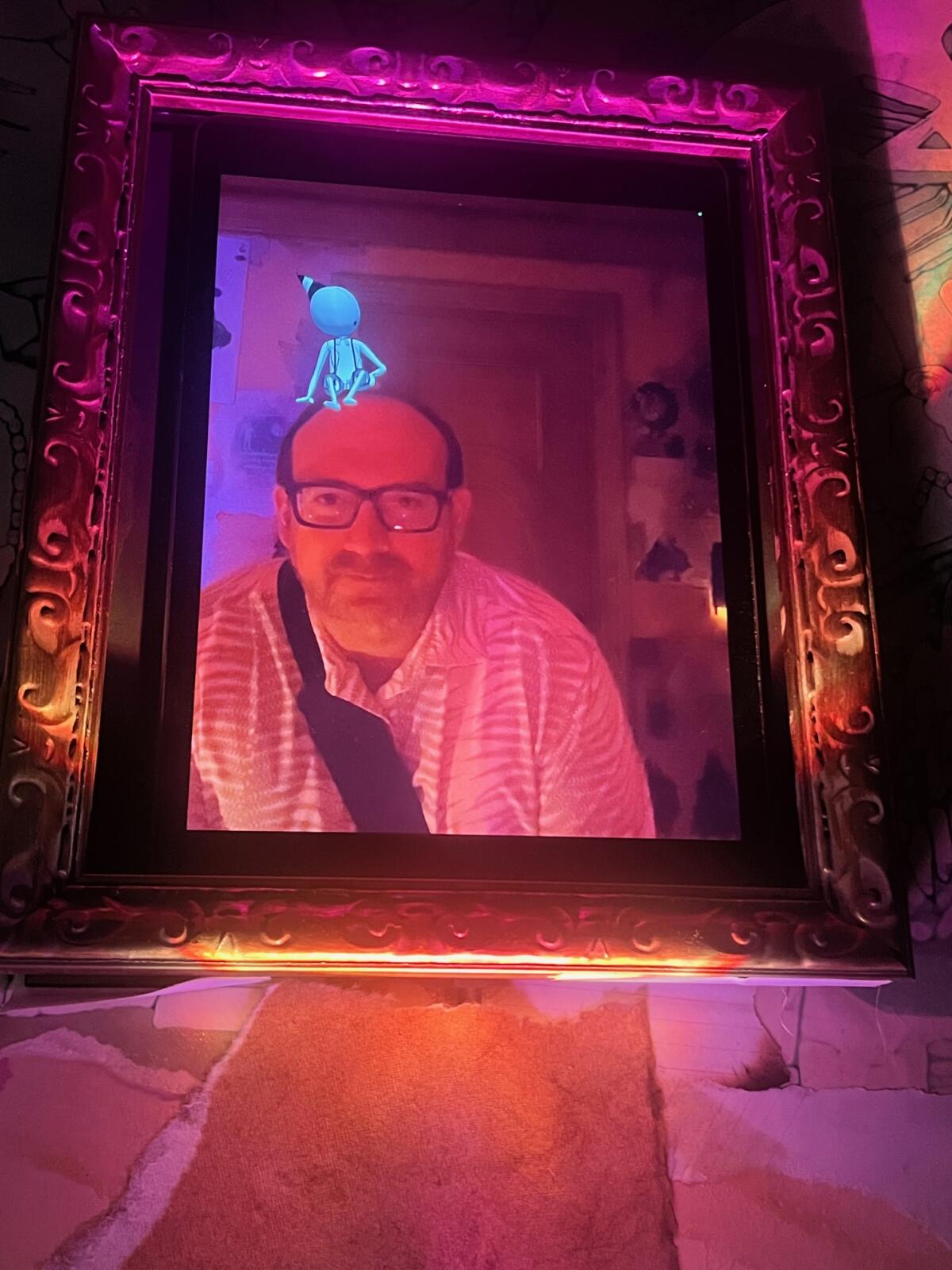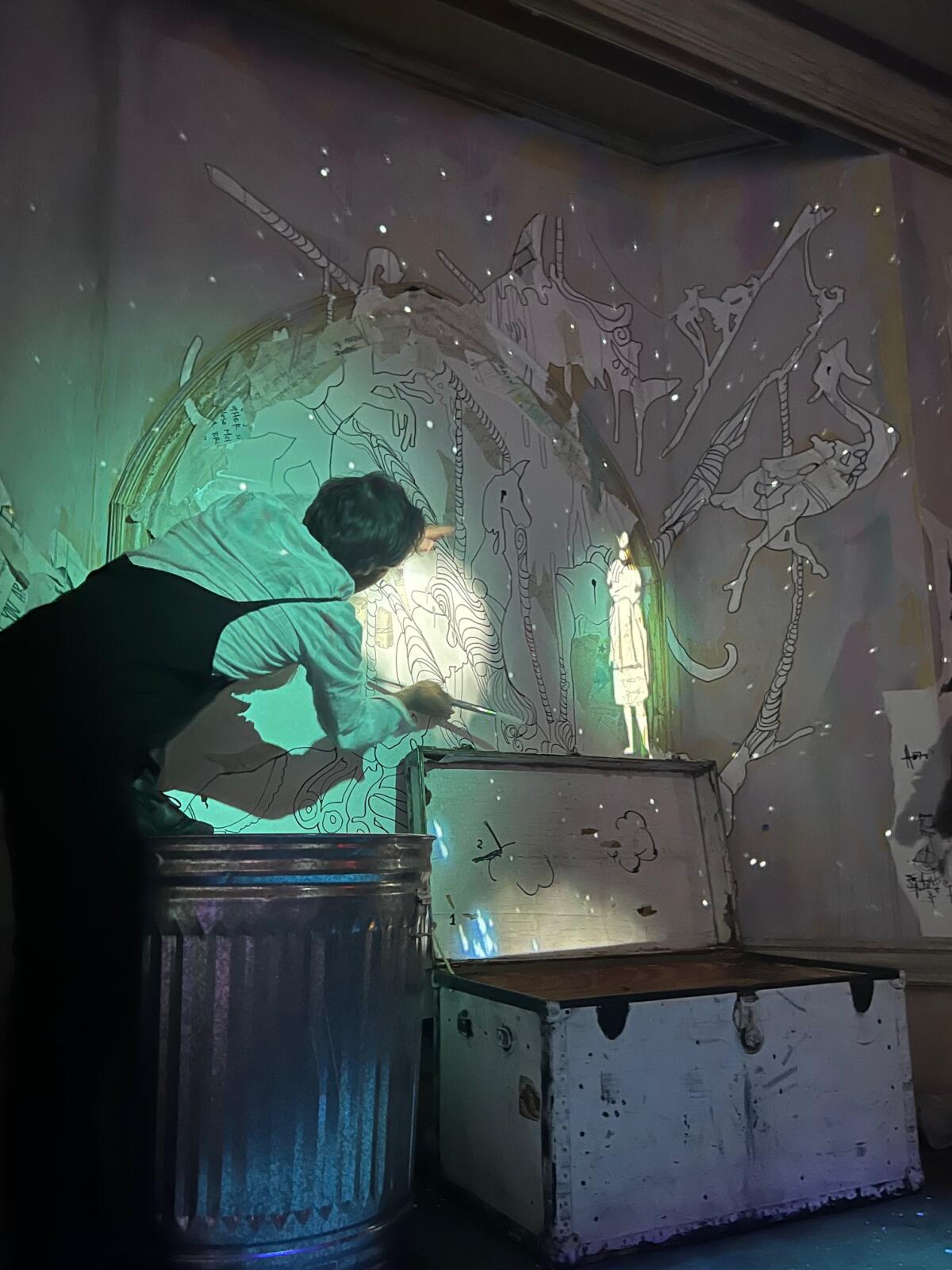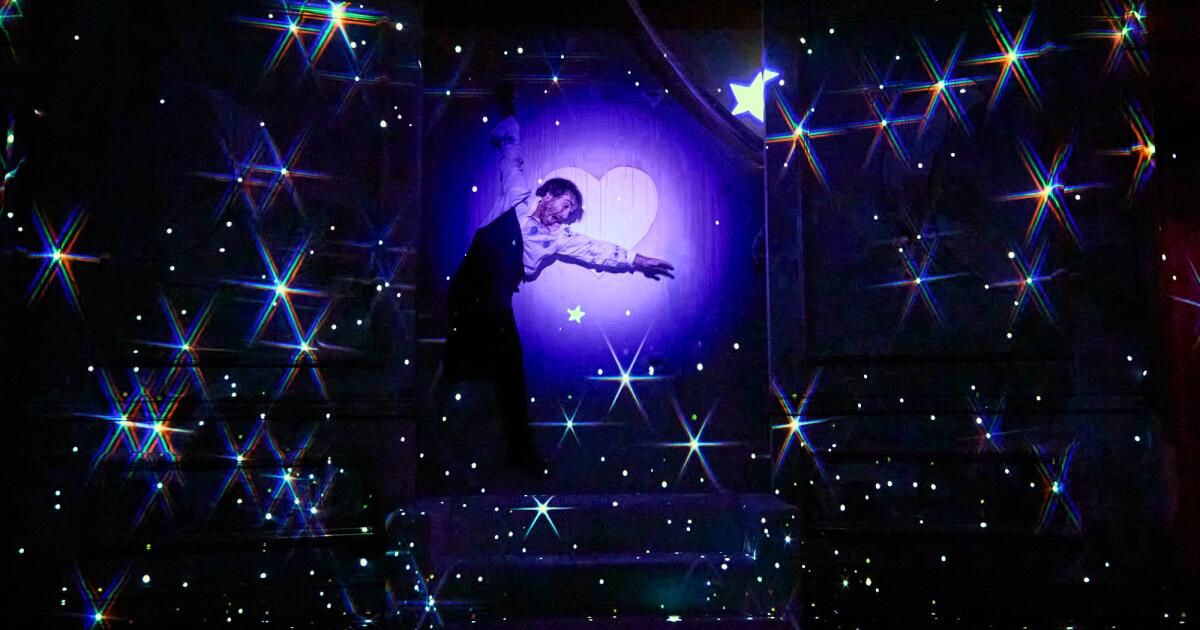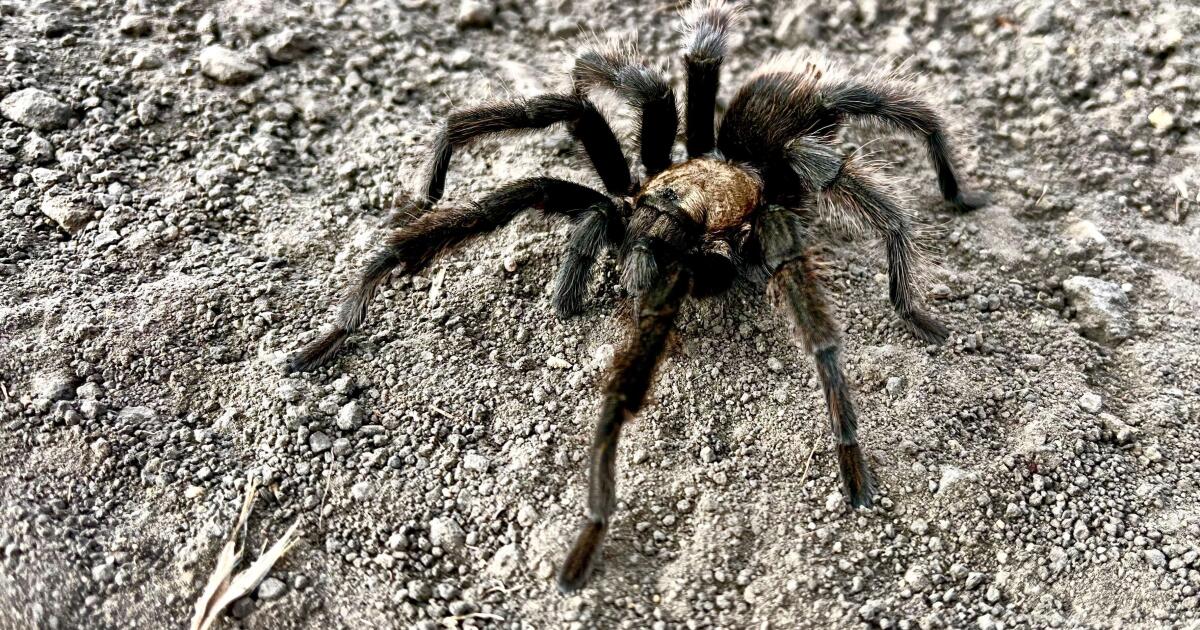There are multiple dance duets in “Particle Ink: House of Shattered Prisms,” a mixed-media theater production that debuted last month on the Las Vegas Strip. They are very acrobatic and almost daring (this is Las Vegas, after all) and are also wonderful feats, since the dance partner is not another human being but an animated character.
Particle is its name and it is a bright white figure with a circular head and a rectangular body, a mixture of simple shapes that can convey a variety of human emotions through elastic and exaggerated movements. Animation, rooted in the imagination, has long had the power to amplify human feelings and enhance reality. But in “Particle Ink,” animation enters our reality, when Particle, for example, jumps from the wall to the pillow, crosses the curtain of a bed, and even cries in a physical cube.
“I wish it were 3-D,” Particle scribbles at a spot on the wall, but the program makes us believe he's jumping between us. Look in a mirror and Particle sits and walks on our heads, essentially becoming an animated virtual pet. At one point, a dancer contorts as she carries Particle, encased in a cage, across a room. The actors appear to hold Particle's hand, and Particle even fights metaphorical demons, her projected body jumping across a room and in and out of a toilet bowl.
Animation, with “Particle Ink,” has entered its era of live theater. It does this through a production focused on exploration, which means that guests wander from room to room following the actors as the acts unfold or, in the case of “Particle Ink,” guests can be following animated figures or a puppet.
Think of it, then, as a kind of next-generation “Sleep No More,” New York's full-length immersive production wrapping up this year. Only here, the theme is an original fairy tale rather than “Macbeth,” one in which animation and augmented reality tools are used to explore our inner world, bringing it to life on whimsically and highly patterned walls, floors, and furniture. assets that seem born. of light.
Created by an enigmatic three-person creative team known as LightPoets, a group with roots in Las Vegas, “Particle Ink” dates back to 2017, when a proof-of-concept installation was shown at the Sundance Film Festival. It caught the attention of entertainment industry veterans Jennifer Tuft and Cassandra Rosenthal, who, with their mixed reality company Kaleidoco, have been working to bring “Particle Ink” to life. The show had a brief run in 2022 in downtown Las Vegas, but before the pandemic it was planned for New York, where Kaleidoco once had a 10-year lease on a five-story Manhattan building set aside for the show.
The character Lilith (Dani Maloney) shares a dance with an animated Particle on a bed in “Particle Ink: House of Shattered Prisms,” a new immersive show in Las Vegas.
(Particle Ink)
“We went big,” Tuft says, noting that the group was about six weeks away from loading when the COVID-19 lockdown began and altered “Particle Ink” plans. Most of the initial costs turned out to be recoverable or redirected to a different space. “Particle Ink” is now committed to the Luxor Hotel & Casino for at least four years, residing in what used to be the hotel's wedding chapel.
The introspective fantasy unfolds in multiple black-box rooms with minimalist furnishings: a community ritual center, a library, a bathroom, a bedroom, and a mini forest, among them. The dancing is rigorous, and the performers often seem to be wrestling with themselves as they grapple with sometimes hidden (and sometimes not) existential demons. Fast-moving digital artworks come to life on the walls, many drawn with a magic wand, by an anonymous artist, played by Elenah Claudin, who serves as the show's protagonist.
His rainbow-colored creations emerge from a chest, and at one moment he turns a sofa into a piano and at another he draws a mystical horse and appears to gallop through his invented world. The images split the difference between something childish and whimsical street art. The strategic use of projections between sets allows the animation to feel tangible.
This fusion of technology and animation into a believable landscape (what the LightPoets call the “2.5 dimension”) is the triumph of “particle ink.” But it is not the heart of the program. Ultimately, this is a story about loss and the quest to regain balance after extreme pain. A black-light doodle on the wall of the show's lobby explains it: “Some of us are dead,” alluding to characters in the show who may live only as memories or creative visions.
“It's about everything from childhood wonder to pain and loss to really accepting yourself,” Tuft says. “It's about striking a balance between looking inward and understanding yourself. “These are concepts that don't necessarily lend themselves to what people generally consider 'Las Vegas entertainment.'”

Times game critic Todd Martens interacts with the animated character Particle in the new immersive Las Vegas show “Particle Ink: House of Shattered Prisms.”
(Todd Martens / Los Angeles Times)
And yet, here it is, with nods to mysticism, as well as the art of tarot and oracles. Ultimately, “Particle Ink” strives to tell a personal narrative about the journey to regain creativity, relying primarily on movement and animation to do so. There's little dialogue outside of a wandering puppet, a kind of wise man who can exist between worlds (or fill in narrative gaps for those who choose to focus on one of the show's touchscreen-like walls and a handful of augmented reality devices that the adventures progress). of Particle and his friends).
“Particle Ink” is a story of heartbreak. It follows the artist, his partner Lilith (Dani Maloney), and the world he conjures. It is inspired by ancient tales about light and darkness, and how our minds are factories of fascination but also places of prison. He also wants to remix the theatrical experience, as it not only relies heavily on technology but also takes influences from the gaming world. A projection of a drawn sword emerges on a wall and then becomes a prop for a battle scene. Its narrative is also quest-based, a journey by Particle to recover pieces of its creator's broken heart.

Animation comes to life through light and projections in “Particle Ink: House of Shattered Prisms,” a show that explores how an artist (Elenah Claudin) harnesses the power of creativity to overcome pain and heartbreak.
(Todd Martens / Los Angeles Times)
Jo Cattell, a Chicago-based theater director and one-third of the LightPoets, sometimes even mixes up the word “player” and “audience member,” pointing out that immersive theater only works if attendees quickly understand the set of rules. of creative work. While there is no real incorporation in “Particle Ink,” the first scene is based around a communal ritual centered around light-gathering stones, one that allows our distraught artist to briefly tap into his creativity only to quickly lose it again. Particle, then, pushes the audience on a journey to recover their splintered heart.
I watched “Particle Ink” twice, the first night focusing primarily on interacting with the animation. Throughout the theater space are tablets that reconfigure to look and feel like magic mirrors, additional glimpses of the so-called 2.5 dimension. The second night, however, I decided to focus on the narrative and found both charm and heartbreak in the way Particle strives to heal its creator's broken heart: Particle's small size, its playful nature, and its drawn feel. by hand they created a feeling of fragility. . Grief can be a rebellious place, but I was moved by the way “Particle Ink” used creative tools (painting, creating, and animation) to show how what we lose continues to live with us.
When thinking about the future of theater, Cattell wonders about today's younger generations, weaned off smartphones and games. While she says this is not a LightPoets thesis, she is eager to experiment with ways to make theater a more active experience. The downside is that the experience is less controlled, but those accompanying it may focus on certain characters or emotions. In theory, she creates a more personal show.
“I don't want to call it a playground because I think it has connotations,” Cattell says. “But we definitely want people to play, create, have fun and enjoy themselves, but at the same time see something that can move them. Depending on who they are or where they are in their lives, it could break their heart.”
'Particle Ink: The House of Shattered Prisms'
Manifestations of pain and inner turmoil emerge here as giant characters dressed as inkblots. The metaphor is not very difficult to discover: with depression and loss of purpose, life loses color. But what matters is how the story is told, and with a very athletic mix of animation and dance, “Particle Ink” consists of 75 minutes of unexpected theatrical interactions. Cattell, for example, estimates that there are about 10 hours of original animation, and creating a show in which artists interacted with walls and objects was a challenge.
“When you go to drama school, they don't teach you to play with walls,” Cattell says. “It's been interesting coming from a theater background. Let's break the rules. We are breaking rules in storytelling, in genre and format. But there's a reason those rules exist. How can we make sure that the performer connects with the audience when he is now distancing himself from the audience?
The solution: find a way for those animated characters tied to the wall to free themselves. And then let them dance.












